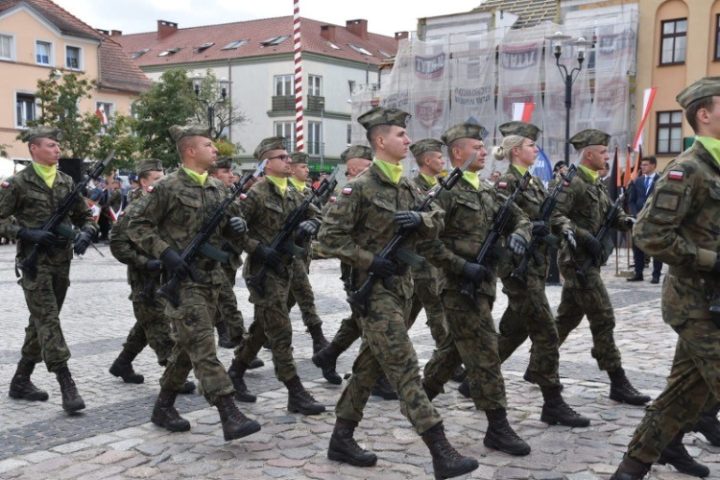
Poland’s armed forces have hired the largest number of soldiers since ending conscription in 2008, as Russia’s actions in Ukraine have stoked motivation to defend the country.
The country recruited over 13,500 professional soldiers last year, Defense Minister Mariusz Blaszczak announced on January 28. This number amounts to about eight percent of Poland’s total armed forces of 164,000.
Poland, which lies adjacent to the Russian exclave of Kaliningrad, plans to raise its armed forces to 300,000 professional soldiers in the near future.
Moreover, it aims to reduce training time on German Leopard 2 battle tanks to five weeks at a center where Ukrainian soldiers are likely to be trained on how to operate the tanks.
The village of Swietoszow in western Poland, near the German border, is home to one of just three Leopard training centers in Europe, with the other two in Germany and Switzerland.
Although the Polish military did not confirm the location where Ukrainian soldiers would be trained, military experts said Swietoszow was the most likely location.
“It is possible or even likely that the training of Ukrainian Leopard 2 tank crews will take place in Swietoszow, but other locations cannot be ruled out,” said Jakub Pawlowski, military expert and deputy editor-in-chief of Defence24.pl.
A group of Ukraine’s Western supporters was set up in January to supply Kyiv with German-made Leopard tanks. Ukrainian Defense Minister Oleksii Reznikov also said last month that Ukrainian troops would be trained on Leopards in Poland.
At a training center bedecked with simulators, 14 crews of four personnel each can undergo training in one go.
Training on the Leopard — a heavy main battle tank used by many NATO member countries in Europe — previously required about 10 weeks, but this time round, training could be reduced to five, instructors revealed.
“If we intensify training (by maximizing the number of) instructors, our time and our weekends, we can train an entire crew in five weeks,” Major Maciej Banaszynski, Poland’s Leopard training center commander, told Reuters.
“Leopard tanks are third-generation tanks. Their mobility on diverse terrain is better compared with Russian tanks,” said chief warrant officer Lukasz Setny, a senior Leopard instructor.
“A [Russian tank] is like having a new Fiat 26p rather than a second-hand Mercedes. It is easier and more comfortable to drive an old Mercedes than a new Fiat 126p,” he said.
Besides, Major Banaszynski said Polish instructors were conducting Leopard training courses for tank crews and for drivers.
“In addition, we now run courses for mechanics for the arms, chassis and equipment accompanying Leopards,” he said.
The only tank Ukraine has used thus far to counter Russia’s actions has been the T-72, a legacy from the former Soviet Union.
However, Poland’s Leopard trainers said it was easy to switch from operating old- to new-generation battle tanks.
Poland, the first country to offer to send Leopards to Ukraine, sharply decried Berlin’s hesitancy in its approval to deploy the powerful German-made tanks to Ukraine.
Kyiv had long requested that Berlin authorize shipments of the high-performance tanks, sparking incessant diplomatic lobbying from its European allies, with the United States also contributing significantly to the lobbying.
As allies waited for Berlin to green light the sending of the tanks, Warsaw mounted pressure on Berlin, asserting it would send the tanks even if Germany disapproved of it.
“Our diplomatic moves and bilateral discussions brought the expected result,” Poland’s Deputy Defense Minister Wojciech Skurkiewicz told reporters after the German announcement.
Poland has been a staunch advocate of neighboring Ukraine since day one of the conflict, fearing further Russian incursions westward that may infringe upon its sovereignty.
The EU member immediately extended an indiscriminate welcome to refugees from Ukraine, more than any other nation, and has supplied immense assistance and arms to the war-torn country.
Poland’s efforts in lobbying for the tanks in coordination with other allied countries merited Kyiv’s praise.
“I thank Poland for their leadership and determination regarding Leopard 2 tanks for Ukraine and building an international coalition,” Ukraine’s ambassador to Poland Vasyl Zvarych wrote on Twitter.
Ukraine, which is still using Soviet-era tanks, claims the Leopard could be vital in helping it overcome the Russians.
Meanwhile, Germany said it would send 14 of its Leopards, and permit other European nations to send tanks from their own stocks.
Polish Prime Minister Mateusz Morawiecki lauded the decision as “a big step towards stopping Russia,” while presidential aide Marcin Przydacz praised his country’s “effective diplomacy.” Morawiecki added that the Poles — and other Western allies he did not identify — are already training Ukrainian soldiers in Poland on how to use the Leopards.
Political scientist Klaus Bachmann said Poland’s role should be regarded as part of a broader diplomatic campaign.
“Crucial here was the position of the US,” the professor at Warsaw’s SWPS University told AFP.
“It’s been like that since the beginning of the Russian invasion: the German government has doubts, then there’s a conversation with the US, and the German government bends,” he added.
Based on a tweet by Artis Pabriks, Latvia’s defense minister until last month, the tank issue stoked questions about Europe’s strategic autonomy.
“How can this continent be militarily autonomous if larger countries cannot make right decisions in the right time without [the] US holding their hand?” he questioned.
In Poland, the tank dispute became part of the political debate prior to a general election later this year.
Morawiecki lampooned the opposition as being soft on Germany, calling out former Polish premier Donald Tusk.
“It is quite telling that neither Donald Tusk nor Civic Platform [the main opposition party] push Germans too hard,” he said.
Last June, the globalist EU agreed to put Ukraine on a path toward membership in the bloc as well. To join the group, countries must meet economic and political criteria dictated by the supranational organization. Also, Ukraine applied to join NATO, yet the military alliance has not extended its invitation due to the country’s disputed borders, flaws in its defense establishment, as well as its track record of corruption.



